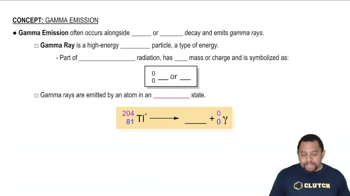Here are the essential concepts you must grasp in order to answer the question correctly.
Radioactive Decay
Radioactive decay is the process by which unstable atomic nuclei lose energy by emitting radiation. This can occur in various forms, including alpha and beta decay. In alpha decay, an atomic nucleus emits an alpha particle (two protons and two neutrons), while in beta decay, a neutron is transformed into a proton, emitting a beta particle (an electron or positron). Understanding these processes is crucial for analyzing decay series.
Recommended video:
Rate of Radioactive Decay
Decay Series
A decay series is a sequence of radioactive decays that an unstable nucleus undergoes until it reaches a stable end product. Each step in the series involves the transformation of one element into another, often through multiple alpha and beta emissions. In the case of uranium-235 decaying to lead-207, the series includes several intermediate isotopes, each with its own decay path.
Recommended video:
Alpha and Beta Emissions
Alpha and beta emissions are two primary types of radioactive decay. Alpha emissions reduce the atomic number by two and the mass number by four, while beta emissions increase the atomic number by one without changing the mass number. The balance of these emissions in a decay series determines the number of steps and the types of isotopes produced before reaching a stable nucleus, such as lead-207.
Recommended video:

 Verified step by step guidance
Verified step by step guidance

